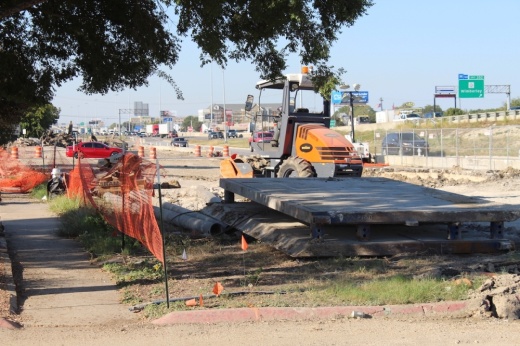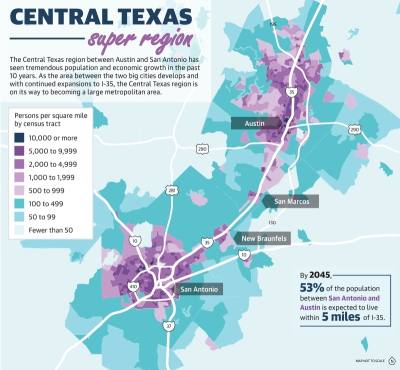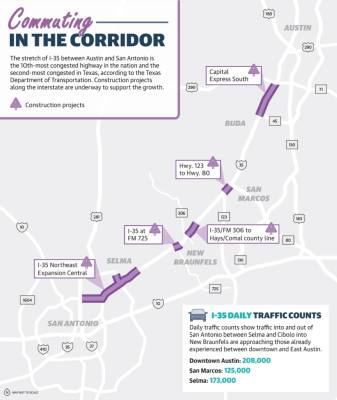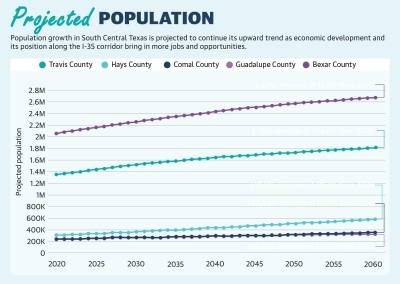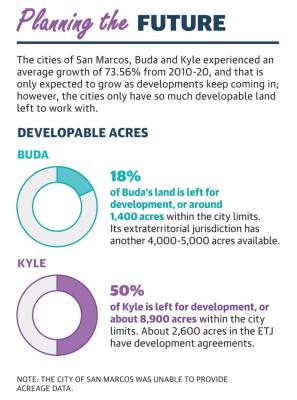By 2045, 53% of the population between San Antonio and Austin is expected to live within 5 miles of I-35, according to a 2019 study by the Capital Area Metropolitan Planning Organization and the Alamo Area Metropolitan Planning Organization.
In this study, the two organizations analyzed growth in the counties between San Antonio and Austin.
By 2060, Bexar County is projected to reach a population of more than 2.6 million, and Travis County is expected to reach more than 1.7 million, according to data from the Texas Demographic Center.
Growth along the corridor is attractive to potential new residents and businesses alike according to local officials.
“Austin and San Antonio are projected to double their population in the next 20 years. We’re growing faster than they are so I think you are going to see the conversion of those two cities become an easier, faster way to get from one to the other,” said Jason Giulietti, president and CEO of the Greater San Marcos Partnership. “Alongside that being really densely populated with industry growth and jobs, it is a destination for companies to find.”
From 2022-60, Hays County is expected to have a 105% increase in population, while Comal County is projected to increase by 74%, and Guadalupe County will increase by 47%, according to data from the TDC.
Alongside population increases, traffic will increase throughout the corridor and businesses will continue to move in, leaving organizations like AAMPO and CAMPO to plan ahead and prioritize future road projects.
Connecting the corridor
Laura Lopez, the San Antonio District public information officer for the Texas Department of Transportation, said the organization is working to address future traffic growth and congestion on I-35.
Each day, between 100,000 and 150,000 vehicles use the section of I-35 between San Antonio and Austin. Many of these vehicles are carrying people commuting between the two cities on a daily basis, Lopez said.
TxDOT projects include the I-35 Northeast Expansion, which is a three-part project that will add elevated lanes and additional lanes on the highway.
The central portion of the project broke ground in May, and will add 9.5 miles of elevated non-tolled lanes from I-410 North to FM 3009, Lopez said.
This $1.5 billion project is part of the Texas Clear Lanes initiative, which focuses on addressing congestion throughout the state. The project is expected to be completed in 2027.
In 2024, TxDOT will begin work on I-35 NEX South, which runs from N. Walters Street to Loop 410 North.
The final portion of the three-part project will be I-35 NEX North, which will focus on the area of I-35 between FM 3009 and FM 1103. This project is currently unfunded, according to Lopez.
Lopez said even with the increase in vehicles traveling on I-35 NEX, future travel times are expected to improve by 41% to 48% on I-35 from FM 3009 to the AT&T Center, which is 15.5 miles.
“Without the I-35 NEX project, travel time is about 29 minutes on the main lanes of I-35,” she said. “With the I-35 NEX project, travel time will be 17 minutes on the main lanes, and 15 minutes on the elevated lanes.”
In Austin, TxDOT broke ground on its I-35 Capital Express South project in November as I-35 is one of the most congested highways in Texas and serves as the “backbone” to local and regional transportation.
The $548 million project is separated into four phases, starting at Ben White Boulevard and travels south to the Travis and Hays County line, north of Buda, adding two high-occupancy-vehicle lanes in each direction.
Capital Express South will not only seek to increase connectivity up and down I-35, but also east and west over or under I-35.
“It is going to have a significant impact on travelers that go up and down the I-35 corridor, specifically [those] coming out of Buda or getting into Austin,” South Travis/Hays County engineer William Semora, Jr. said.
The project is expected to be completed in 2028.
Traversing the future
In 1984, the Greater Austin-San Antonio Corridor Council was created to support long-term infrastructure and economic development for the Austin-San Antonio Corridor.
The organization is a regional nonprofit public/private partnership composed of more than 130 political jurisdictions, public authorities and businesses.
Corridor Council President Ross Milloy said $10 billion will be put into I-35 growth over the next 5-10 years from planned projects alone.
According to Milloy, Austin is growing as a manufacturing center with companies such as Tesla moving in.
With that growth, Milloy said it would be beneficial to address east to west access traffic from Austin down I-10 to help with traffic flow from cities such as Houston, which would help in diluting traffic around the metro.
In 2016, the Lone Star Rail District, which was to be a commuter rail between Austin and San Antonio, died after a vote from CAMPO.
Despite the end of this project, Milloy believes that a rail between the two cities is likely to return.
“I still think that a rail connection between Austin and San Antonio is necessary and inevitable,” he said. “It is unfortunate what happened with Lone Star Rail, but that is in the past and there are some new programs from the Feds that I think are exploring this.”
Milloy said programs from organizations such as Amtrak could be helpful in a new project or initiative in the future.
Another organization, San Antonio-based VIA Metropolitan Transit, is working to start a pilot program which will provide public bus routes between the two cities with stops in San Marcos and New Braunfels.
Outside of public transportation, Milloy said the organization is also focusing on electric vehicles and the electrification of the corridor.
Other concerns for the corridor, especially within Austin and San Antonio, are water and air quality, according to Milloy.
“Air quality continues to be a concern,” he said. “San Antonio, I think, is probably moving into non-attainment and Austin is probably not far away.”
Should the two cities move into non-attainment, it would lead to restrictions on development and could lead to inspection fees across Bexar County, according to Milloy.
To help fight pollution, the Electric Transportation Compact was created in 2020.
This organization is tasked with responding to the leading cause of air pollution in the South Central Texas region.
Bexar and Travis counties work with this organization to upgrade their fleets to electric vehicles and work to promote electrification of vehicles in the two counties.
While pushing for electric vehicles and a new rail system to address future growth and development needs, there is still an issue of congestion, leaving I-35 to need extra capacity sooner, Milloy said.
“I think we are going to have to rely on trying to beef up high-capacity transit between Austin and San Antonio,” he said.
Economic growth
San Antonio Mayor Ron Nirenberg said the growth of the corridor into a metroplex is an economic inevitability.
“My hope is that in the process, the two cities become better versions of themselves, and specifically San Antonio continues to grow into a more inclusively prosperous place that retains its unique cultural heritage,” Nirenberg said.
According to Nirenberg, the city is preparing for growth by focusing on efforts to address housing affordability, which will be funded through the $150 million housing bond proposition approved in May.
Nirenberg said he would also like the city to look towards connectivity between the East and West sides.
“With progress on the North-South line well underway, it’s time to look even further into the future and plot a course for a corridor connecting East and West San Antonio—and elevate the potential of historically underserved areas,” he said. “We need to make this happen sooner rather than later.”
As Austin and San Antonio continue to thrive and prosper, the cities in between must race to keep up with demand.
Jonathan Packer, President and CEO of the Greater New Braunfels Chamber of Commerce, said he thinks the Austin and San Antonio region has a lot of the characteristics that make up a strong metroplex such as having two airports, a highway connection and significant economic development in unique business sectors.
“I think one other hallmark that's really important where we have more work to do is just on the general collaboration between the two cities and the other cities in the region,” Packer said. “So I think that's an area that you know, as we look to the future, cities learning to work together more intentionally and collaboratively as a region is the next wave that I look forward to seeing.”
Traversed by and adjacent to the I-35 corridor are Hays and Caldwell counties, which are overseen by the Greater San Marcos Partnership.
“All the communities within those two counties are all partners in the [GSMP] so our intent is to bring the jobs and for the last three years... we have basically been breaking every record the organization’s ever set, in terms of hitting that mission,” Giulietti said.
The GSMP has brought in more than $2 billion of new investments to its communities, which directly translates to thousands of jobs, according to Giulietti.
Growing in droves
Of U.S. counties with a population of 100,000 or more, Hays County was ranked the fastest-growing county from 2010-2020 with 53% growth.
The growth rate is not the only thing attracting large corporations to set up shop in Hays County, bolstering the corridor between the metropolitan cities of Austin and San Antonio.
“Being in the Central Time Zone makes a huge difference, that’s the first selling point. Second is you’re around two huge growing cities, being in between the two is a tremendous benefit,” Guilietti said. “The biggest challenges companies have around the world right now in locating new companies is workforce. Where do you have a workforce-talent pipeline to build your 1,000-person facility? Here, people are coming in droves, and they’re coming with all skill sets.”
Not only is the Hays County area attracting talent from across the nation, but Texas State University is in San Marcos, one of the largest public universities in the state, he said.
“We have a really great relationship with Texas State. That’s part of what we are driven to do, is bring more jobs here to keep those students here, versus having them go to Austin [or] San Antonio,” Giulietti said.
He added that over the next several years, the landscape between I-35 and SH-130 will begin to disappear and blend into one bustling area. In either direction off I-35, east or west, there is a lot of vacant land, ripe for the picking of any large-scale company or corporation to build its next site.
However, not all cities throughout Hays County have the same amount of land available to its disposal for build-out.
The city of Buda only has around 18% of land available for development, or around 1,400 acres. However, they do have almost double the amount of land available for annexation and development from its ETJ, at around 4-5,000 acres.
Buda city staff are in the process of creating its long-term, comprehensive plan that will detail exactly how much land is left and how the city can utilize it as best as possible to accommodate its growth and community’s needs.
The city of Kyle is about 50% built-out on its 20,928 acres. Within city limits, there are around 8,900 acres available for development with only 2,600 acres of land from its extraterritorial jurisdiction available for annexation and development.
Businesses seeking available spaces often contact the Economic Development Department for assistance in finding the spot perfect for them.
Incentivizing businesses
The city of Kyle has three main incentive agreements that it can enter with businesses or corporations, depending on the terms, the first of which is the “First Year on Us” incentive.
“That is for anyone that wants to construct a facility or if they want to renovate their existing facility. What that does is it rebates back their first year property taxes based on the increment value of the increase,” Director of Kyle’s Economic Development Victoria Vargas said.
The second incentive offered is the Restaurant Incentive which is used at city council discretion.
The ED team works to bring forth proposals for potential restaurants that could become a regional destination and would fill a cuisine gap the city needs.
“What we look at is a rebate on their sales tax and/or property tax,” Vargas said.
The third incentive is the most common and is used by cities across the state, a Chapter 380 agreement.
“What we can do with that one is rebate taxes, property taxes and sales tax. That is done through a lot of negotiation,” Vargas said.
Potential capital investment, job creation, average wages, facility and location are all factors that aid in the negotiation process.
The city of Kyle is also working on its comprehensive plan, spearheaded by the planning department, called Kyle 2030.
“That plan is so very important because it lays out where development will go for the next 10 years,” Vargas said.






